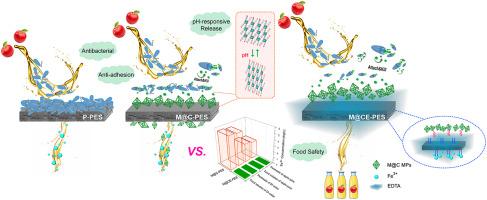无污染MIL-53(Fe)锚定超滤膜用于苹果汁杀菌:抗生物污染性能及机理
IF 5.8
2区 农林科学
Q1 ENGINEERING, CHEMICAL
引用次数: 0
摘要
抑酸藻残留严重影响果汁品质。传统的热处理不能完全消除细菌,同时导致热敏成分的损失。超滤(UF)已成为传统热法灭菌苹果汁的一种非热替代方法。然而,膜污染,特别是生物污染是UF在食品加工中应用的一个障碍。为了在保证食品安全的同时解决膜生物污染的难题,采用金属螯合剂包覆和绿原酸包埋MIL-53(Fe)微粒接枝等多阶段改性技术开发了功能化UF膜。应用该工程膜对苹果汁进行冷杀菌,去除嗜酸嗜酸杆菌。结果表明:(1)在pH刺激下,工程膜能够释放绿原酸;(2)污染苹果汁过滤后,工程膜的稳态通量保持在高于原始膜的水平。(3)工程膜的抑菌机制主要是由于破坏了细胞结构的完整性,增强了细胞膜的通透性,从而对酸地草细胞造成了损伤;(4)过滤后,渗透液中Fe3+的浓度几乎检测不到。该工程膜能同时排除和灭活苹果汁中的酸僵菌,同时表现出优异的抗粘附和抗生物污染性能。此外,该工程膜符合食品安全要求,验证了这种金属有机框架修饰方法在食品加工中的实际应用潜力。本文章由计算机程序翻译,如有差异,请以英文原文为准。

Non-contaminative MIL-53(Fe)-anchored ultrafiltration membrane for apple juice sterilization: Anti-biofouling performance and mechanism
Residual Alicyclobacillus acidoterrestris severely impacts juice quality. Conventional thermal treatments fail to completely eliminate bacteria and simultaneously cause the loss of heat-sensitive components. Ultrafiltration (UF) has been a nonthermal alternative to conventional thermal process for the sterilization of apple juice. However, membrane fouling, particularly biofouling is an obstacle for deployment of UF in food processing. In order to tackle the challenging issue of membrane biofouling while ensuring food safety, functionalized UF membrane was developed by multi-stage modifications including metal chelator coating and chlorogenic acid-encapsulated MIL-53(Fe) microparticle grafting. The engineered membrane was applied for cold sterilization of apple juice to remove Alicyclobacillus acidoterrestris. Results showed that (i) the engineered membrane could release chlorogenic acid in response to pH stimulation, (ii) the steady state flux of engineered membrane was maintained higher than the pristine membrane after filtration with contaminated apple juice. Only 4.9 % viable bacteria were observed on the membrane surface, (iii) the antibacterial mechanism of engineered membrane was mainly due to the disruption of cellular structural integrity and enhanced permeability of cell membranes, which caused the damage to A. acidoterrestris cell, (iv) after filtration, the Fe3+ concentration in the permeate solution was almost undetectable. The engineered membrane can simultaneously exclude and inactivate A. acidoterrestris in apple juice, while demonstrating excellent anti-adhesion and anti-biofouling properties. Furthermore, the engineered membrane complies with food safety requirements, which verifies that this metal-organic framework modification method has the potential for practical application in food processing.
求助全文
通过发布文献求助,成功后即可免费获取论文全文。
去求助
来源期刊

Journal of Food Engineering
工程技术-工程:化工
CiteScore
11.80
自引率
5.50%
发文量
275
审稿时长
24 days
期刊介绍:
The journal publishes original research and review papers on any subject at the interface between food and engineering, particularly those of relevance to industry, including:
Engineering properties of foods, food physics and physical chemistry; processing, measurement, control, packaging, storage and distribution; engineering aspects of the design and production of novel foods and of food service and catering; design and operation of food processes, plant and equipment; economics of food engineering, including the economics of alternative processes.
Accounts of food engineering achievements are of particular value.
 求助内容:
求助内容: 应助结果提醒方式:
应助结果提醒方式:


